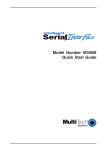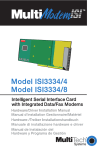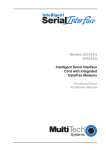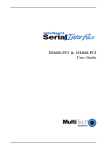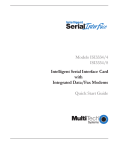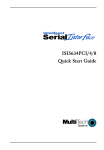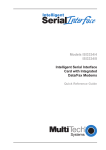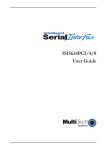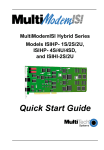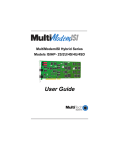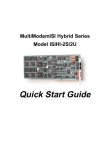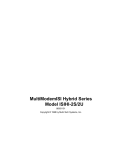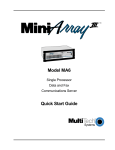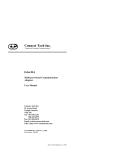Download Multitech ISI608PC Owner`s manual
Transcript
Intelligent Serial Interface Model ISI608PC Card Owner’s Manual Owner's Manual P/N 82033203, Revision D Model #ISI608 This publication may not be reproduced, in whole or in part, without prior expressed written permission from Multi-Tech Systems, Inc. All rights reserved. Copyright © 1996 by Multi-Tech Systems, Inc. Multi-Tech Systems, Inc., makes no representation or warranties with respect to the contents hereof and specifically disclaims any implied warranties of merchantability or fitness for any particular purpose. Furthermore, Multi-Tech Systems, Inc., reserves the right to revise this publication and to make changes from time to time in the content hereof without obligation of Multi-Tech Systems, Inc., to notify any person or organization of such revisions or changes. Record of Revision Revision D (2/12/96) Description Manual revised to include Windows NT Driver installation procedure; and overall technical, editorial and format changes. TRADEMARKS Trademarks of Multi-Tech Systems, Inc. are as follows: Multi-Tech, MultiExpress, and the Multi-Tech logo: Multi-Tech Systems, Inc. UNIX: X/Open Co. Ltd. MS-DOS and Windows NT: Microsoft Corporation SCO: The Santa Cruz Operation, Inc. Pentium: Intel Corporation PC-DOS: International Business Machines Corporation Novell, NetWare, NetWare Connect and UNIXWare: Novell Corporation Xenix:Xerox Corporation Multi-Tech Systems, Inc. 2205 Woodale Drive Mounds View, Minnesota 55112 U.S.A. (612) 785-3500 or (800) 328-9717 U. S. FAX 612-785-9874 Fax-Back Service 612-717-5888 Technical Support (800) 972-2439 BBS (612) 785-3702 or (800) 392-2432 Internet Address: http://www.multitech.com Technical Writer: [email protected] Contents Chapter 1 - Introduction and Description Introduction to the IntelligentSerialInterface .................................. 6 Product Description ....................................................................... 7 How to Use This Manual ............................................................... 8 ISI608 Applications ........................................................................ 8 Technical Specifications ................................................................ 9 Chapter 2 - Hardware Installation Safety Warnings .......................................................................... 12 ISI608 Installation ........................................................................ 12 Determining Current System Settings ......................................... 13 Hardware Installation Procedure ................................................. 14 Chapter 3 - ISI608 Driver Installation Introduction ................................................................................. 20 Novell NetWare Connect AIO Driver Installation ......................... 21 Configuring Ports for NetWare Connect ............................... 23 Removing the Driver (Novell) ................................................ 23 Installing the ISI608 in Windows NT ............................................ 24 Configuring Ports for Windows NT .............................................. 25 Removing the Driver (Windows NT) ............................................ 26 Installation in SCO UNIX ............................................................. 26 Activating Ports in SCO UNIX ..................................................... 28 Removing the Driver (SCO UNIX) ............................................... 30 Installation in SCO XENIX ........................................................... 30 Activating Ports in SCO XENIX ................................................... 32 Removing the Driver (SCO XENIX) ............................................ 34 Installing the ISI608 Driver on a UNIXWare Computer ............... 34 Activating ISI608 Ports on a UNIXWare System ......................... 36 Removing the Driver (UNIXWare) ............................................... 36 The Multi-Tech Installation Script ................................................ 37 Multi_Setup Utility ........................................................................ 41 Multi_View Utility Installation ....................................................... 43 Description File Format ......................................................... 45 Hot Key Entries ..................................................................... 45 Terminal Escape Sequences ................................................ 46 Timing Specification .............................................................. 47 Administration Utility .................................................................... 49 Chapter 4 - Warranty, Service and Tech Support Software User License Agreement .............................................. 52 Limited Warranty ......................................................................... 54 On-line Warranty Registration ..................................................... 54 Tech Support ............................................................................... 55 Recording ISI608 Information ............................................... 55 Service ........................................................................................ 56 About the Multi-Tech BBS ........................................................... 57 How to Use the Multi-Tech BBS ............................................ 57 About CompuServe/Internet ........................................................ 59 About the Multi-Tech Fax-Back Service ...................................... 59 Appendices Appendix A - Determining Current System Settings .................... 62 Appendix B - Base I/O Address Switch Settings ......................... 65 Appendix C - ISI608 Testing Utilities ........................................... 69 Appendix D - Crossover Cable Wiring Diagrams ........................ 74 Index Chapter 1 - Introduction and Description ISI608PC Owner’s Manual Introduction to the IntelligentSerialInterface The new IntelligentSerialInterface card, model ISI608, is a hardware solution for adding fast serial ports to communication servers and async hosts that have 16-bit ISA-bus architecture. Serial ports are essential to communication servers, which pool modems and other communication devices for users on a LAN, and to asynchronous hosts that provide user access through serial ports. The ISI608 ships with a NetWare® Loadable Module (aioisix.nlm) for NetWare Connect communication servers, and drivers for each of the following multiusers operating systems: Windows® NT, SCO® UNIX®, XenixTM, and SCO UNIXWare®. The IntelligentSerialInterface card(s) can be combined to support asynchronous serial devices (local or dial-up). The ports can be used to connect basic terminals with or without multiple pages of memory to multiplexer channels and asynchronous modems. When multiple page terminals are used in an UNIX environment, a utility called "Multi_View" allows you to have multiple sessions. Each ISI608 port can support as many screens as there are physical pages of memory on the terminal. If you have SCO UNIX System V/386 Version 4.0 or later, there is an extended feature supplement (EFS) "rolled into" the operating system which now officially supports data rates up to 33,600 bps; also included is a textdriven configuration facility so the system administrator can create the appropriate modem dialer without having to purchase a "C-Language" programming environment or knowing how to write a dialer program in "C". In an Windows NT environment, there is an built-in "autodetect" utility that enables detection of Multi-Tech modems; this utility sets the proper initilization strings. This manual contains product specification, installation instructions, and technical support information which will assist you in the installation process. It is assumed that you have basic PC skills at the very least. Therefore, we have not included step-by-step instructions for such basic operations as logging in and file editing, etc. 6 1 - Introduction and Description Product Description The ISI608 is a multiport serial port expansion card which adds data buffering on each port for enhanced serial port performance. The ISI608 features an on-board microprocessor to coordinate the communications activity of your local and remote terminals. Using an ISI608 to provide additional serial connections enables your system's processor to perform more efficiently. This is because the ISI608 handles all of the byteby-byte interrupts generated by asynchronous terminals and stores the data in buffers. The processor, along with 256K bytes of RAM work together to dynamically allocate resources to the most active port. The ISI then generates one interrupt for an entire block of information and transfers the block to the system's microprocessor. The ISI608 has one 78-pin (DB78S) connector which interfaces with an eight-port fan-out, or “octopus”, cable (supplied with the card), providing eight additional serial ports. It is a "3/4 size" add-on card which supports a high-speed interface up to 115.2K bps. The ISI608 features one bank of 8 DIP-Switches for I/O address selection and one jumper block for IRQ selection. 7 ISI608PC Owner’s Manual How to Use This Manual This manual contains both hardware and operating system(s) driver installation procedures, technical support, warranty and BBS information and a number of appendices for additional information on selected topics. Hardware configuration and installation procedures are described in Chapter 2. The installation of the ISI608 card also involves linking a driver to the operating system, this information is provided in Chapter 3. An explanation of the Multi_View utility, used in the UNIX environment is available in Chapter 3 as well. Most of the steps listed in the driver installation section instructs you to "press Enter". This is a reference to the key commonly known as the "Enter", "carriage-return", or simply "Return" key. Also, please take the time to notice the difference between the letter O and the number 0. Both the letter and the number may be used within this manual. ISI608 Applications The most common application, is when a powerful microcomputer is being used as a server or host, but lacks enough connectivity to accommodate the desired number of users. For this application, the ISI608 is the solution. The ISI608 provides eight additional serial ports with every card installed, with potentially four additional cards installed per system -- for a total of thirty-two serial ports per system. 8 1 - Introduction and Description Technical Specifications Computer Requirements 386, 486, or Pentium®- based PC or compatible with ISA Bus Architecture * Microsoft Windows NT 3.5x, SCO's UNIX System V/386 (Version 3.2, Release 2.0 or later), SCO's XENIX System V/386 (Version 2.3.2C or later), or UNIXWare (Release 1.1 or later), Novell's Netware * At least one floppy drive * 800 blocks of hard disk space for UNIX; 100 K bytes for Windows NT; 50 K bytes for Novell Physical/Electrical/Environmental * * Dimensions: 9.17" x 4.2" x .06" 23.3 cm x 10.67 cm x .15 cm * Baud Rates: 300 to 115.2K bps per port * Bus Type: ISA or EISA * Connectors: DB78S * Cabling: Eight port fan-out cable. DB78M (male) interface to card, eight DB25 (male) connectors for serial devices * Serial Interface: Eight RS232C or RS232D ports * Temperature: 32° to 120°F (0° to 50°C) * Power: 1.5 amps @ +5v DC * Base I/O One 16-byte address space per card. * Address: Valid options range from 100h to 3F0h (DIP-switch setting) * Interrupt One IRQ per card. Valid options * Request: include 2, 3, 4, 5, 7, 10, 11, 12, & 15 (Jumper setting) * Warranty: Two years Manufactured in Mounds View, MN, U.S.A. 9 ISI608PC Owner’s Manual 10 Chapter 2 - Hardware Installation ISI608PC Owner’s Manual Safety Warnings 1.Never install telephone wiring during a lightning storm. 2.Never install telephone jacks in wet locations unless the jack is specifically designed for wet locations. 3.This product is to be used with UL and CUL listed computers. 4.Never touch uninsulated telephone wires or terminals unless the telephone line has been disconnected at the network interface. 5.Use caution when installing or modifying telephone lines. 6.Avoid using a telephone (other than a cordless type) during an electrical storm. There may be a remote risk of electrical shock from lightning. 7.Do not use the telephone to report a gas leak in the vicinity of the leak. ISI608 Installation This chapter provides you with the procedures to install the Multi-Tech ISI608 card(s) in your ISA or EISA bus personal computer (or compatible with 16 bit ISA slot). Hardware installation involves: 1) Opening your PC. 2) Setting card configuration (determining I/O address DIPSwitch setting and IRQ jumper setting). 3) Installing the card into the PC. 12 2 - Hardware Installation Determining Current System Settings When you install a device into your computer, the processor must have a means of routing information to and from the device and the device must have a means of gaining the processor's attention. These are called Input/Output (I/O) addresses and Interrupt Requests (IRQs), respectively. The ISI608 card requires 16 I/O addresses and one IRQ value which are not used by any other device in your system. When selecting a unique base I/O address, be sure that the next address is also unused. To determine your ISI's current settings, refer to Appendix A and B. If you are certain that these settings are not already in use, continue with the hardware configuration and installation. You can install up to four ISI608 cards into your system. Each card is shipped with its IRQ set at level 3 and a base I/O address of 200 hex. Check your system’s device settings to see if these values can be used. If the defaults are already in use, select a unique IRQ and I/O address and record those values for the hardware and software installation sections that follow. Table 2-1. Recommended Base I/O Address and IRQ Values ISI608 Card Base I/OAddress IRQ Initial First Second Third 200h 210h 220h 230h 3 4 5 7 8 port board 8 port upgrade 8 port upgrade 8 port upgrade Note: If you choose IRQ 3 or 4, you may have to disable a COM device from your BIOS setup. Also, most 386 or higher compatible computers will not be able to assign IRQ2 to the ISI card because IRQ2 is used for slave interrupt control. 13 ISI608PC Owner’s Manual Hardware Installation Procedure Perform the procedures in Table 2-2 to install the ISI608 card(s) into your PC-ISA bus computer. The installation procedures include setting the I/O address switch block and the IRQ jumper. This section may be skipped if the defaults: I/ O Address 200 Hex and IRQ 3 are the values you have selected. However, if you are installing multiple cards, step 4a of Table 2-2 describes how to configure your card(s). Table 2-2 ISI608 Installation Procedure Step Procedure 1 Make sure your computer and any peripheral equipment connected to it are turned off. Failure to do so may damage both your ISI card(s) and your PC. The ISI608 may be installed in a PC-AT, 386, 486, or Pentium equivalent ISA or EISA bus computer. 2 Remove the cover of your computer as instructed in your computer’s documentation. 3 Locate the unused slot(s) which you will be using for your ISI608 card(s), and remove the slot cover(s) per the instructions in your computer’s documentation. 4 Check the settings of the I/O address switch and the IRQ jumper to ensure that they are set properly for your installation. Figure 2-1. ISI608 Board Components 14 2 - Hardware Installation Table 2-2 (cont’d) Step Procedure 4a The default setting for the ISI608’s base I/O address is 200 hex. The default value for the IRQ jumper is IRQ 3. Choose the IRQ value by covering the appropriate pins with the shorting plug (supplied). Reference the diagram shown below, if needed. If your system requires a different setting or if you are installing multiple cards, refer to Appendix B for a table of valid address settings. 200 hex/IRQ 3 Figure 2-2. I/O Address/IRQ Default Setting Note: If you are installing the ISI608 as a second card in a MultiComRNGateway (remote node gateway) the suggested I/O address is 210 hex/IRQ4. 210 hex/IRQ 4 Figure 2-3. I/O Address /IRQ Alternate Setting Record any changes you make to these settings and keep them handy for the software installation section in Chapter 3. 15 ISI608PC Owner’s Manual Table 2-2 (cont’d) Step Procedure 5 Install the ISI608 card(s) into the selected expansion slot(s) in the same manner as any other add-on card, as instructed in your computer’s documentation. 6 Fasten the retaining bracket to the computer chassis and replace the cover. 7 Attach the octopus cable to the DB78S female connector on the ISI608 card at the back of your computer. The RS232 ports provided by the octopus cable are for connection to modems, multiplexers or other devices. If the other device is a local terminal port, then a crossover cable is required (not included) between the octopus cable and the terminal port. See Appendix D for schematic of a crossover cable. NOTE Any cables connected to the computer must be shielded to reduce interference. Figure 2-4. Octopus Cable 16 2 - Hardware Installation Table 2-2 (cont’d) Step Procedure 8 Turn power on to the computer and refer to the manual that was provided with the software you will be using with the ISI608 in order to perform software installation procedures. NOTE If the ISI608 card is being used as an expansion card (Remote Node--model #RNI08) for the MultiComRNGateway, then you must reconfigure the gateway software, using the RNSERCON.EXE program. You will need to add the card's settings to the Board Information entry and assign access rights to each user under the User Information entry. See Chapter Three of the MultiComRNGateway Owners manual for server configuration. 17 ISI608PC Owner’s Manual 18 Chapter 3 - ISI608 Driver Installation ISI608PC Owner’s Manual Introduction The ISI608 ships with a NetWare® Loadable Module (aioisix.nlm) for NetWare Connect communication Servers, and drivers for each of the following multiusers operating systems: Windows® NT, SCO® UNIX®, SCO XenixTM, and SCO UNIXWare®. This chapter will guide you through the installation of these drivers. Section 3.9 details the Multi-Tech Installation Script, which is executed by a UNIX operating system. As with all software, you should make a backup copy of the diskette you received and use the copy for the installation. If you received a 3½" diskette, the capacity is 720KB. Consult your system manual for instructions on disk copying. Also, if you have a numeric keypad, and you intend to use it for the installation process, make sure you have "Num Lock" on. The process of installing a device driver consists of a modification to your system. For this reason, only the "super user" (system administrator) is allowed to perform the installation. If you cannot login as the root, you must find the person in your organization who has this authorization (i.e., password). To begin the driver installation, login as root. Then proceed with the appropriate section. 20 3 - ISI608 Driver Installation Novell NetWare Connect AIO Driver Installation Multi-Tech Systems provides “AIO” drivers for the ISI608, so that it can function with Novell compatible asynchronous applications (i.e., NetWare Connect). The drivers need to be loaded on the file server in which the board(s) is/are installed. The drivers can be loaded from the file server’s console prompt or they can be incorporated, for autoloading, in the AUTOEXEC.NCF file. The AIO driver is simply an NLM (NetWare Loadable Module) which runs on the file server. To install the Multi-Tech AIO driver, copy the file “AIOISIX.NLM” to the system directory of the file server from a workstation on the network. For example, you may use the following command to do the copy: COPY A:\AIOISIX.NLM F:\SYSTEM To load the AIO driver, go to the system or PC (in which the ISI608 resides) console and at the prompt (:) type: LOAD AIOISIX [port=W] [int=X] [name=Y] [node=Z] where W is the hexadecimal I/O port address for the ISI608. The ISI608 occupies the next 15 I/O addresses on the bus. That is, if you specify the address 100 hex, then the ISI608 will occupy the addresses from 100 hex to 10F hex (total of 16 addresses). X is the interrupt (IRQ) vector number for the ISI608. The ISI608 can be set for IRQ vectors 2, 3, 4, 5, 7, 10, 11, 12 & 15. Y sets the ISI608 board name. Z overrides the default node ID number for the ISI608. Note that all these parameters are optional. In a case where none of them are supplied, the ISI608 AIO driver will assume the default I/O address and IRQ values and try to load the driver. 21 ISI608PC Owner’s Manual IRQ Jumpers Setting IRQs consists of installing the IRQ jumper on the two pins that indicate the interrupt vector. For example, IRQ3 is chosen in the configuration below. 2 3 4 5 7 10 11 12 15 : [:] : : : : : : : Error Messages 1. *Error: An ISI608 does not seem to appear at address X* This means that the driver could not find the ISI608 residing at the address X. Make sure that there is no other device in your system at the same I/O address. Make sure that the ISI608 is seated properly in the system slot. 2. *Error: ISI608 rejected the load header* *Error: ISI608 got out of sync* *Error: ISI608 verify failed at address X* *Error: Expected X received Y* *Error: Verify got out of sync* All the above errors represent problems with the file server not being able to communicate with the ISI608. Make sure that you do not have any other device residing in the system at the same I/O address you have chosen for the ISI608. Power down the server, make sure that the ISI608 is seated properly in the system slot. Power up the file server and try to load the AIO driver again. If the problem persists, contact the MultiTech Technical Support team. 22 3 - ISI608 Driver Installation Troubleshooting Problem: I loaded the driver at the file server console, then I started NetWare Connect and connected a modem to a port on an ISI608. When I try to communicate with the modem, I see the DTR of the modem being raised, but the modem does not respond to my AT commands. Solution: There might be an IRQ conflict between an ISI608 and some other hardware in your system. Even though that particular device (for example, a mouse) is not activated under NetWare, that device will still control the IRQ. Refer to your system's documentation to find out how to disable that device. Configuring Ports for NetWare Connect To set-up NetWare Connect ports, type LOAD NWCCON at the NetWare console prompt. This command string will invoke the NetWare Connect Configuration Utility. Choose the appropriate menu options (e.g., modem type, speed and flow control...). Removing the Driver (Novell) In Novell, remove file “AIOISIX.NLM” from the System Directory and make the appropiate changes to the Autoexec.ncf. file. 23 ISI608PC Owner’s Manual Installing the ISI608 in Windows NT The following procedure describes how to install the ISI608 in a system running Microsoft Windows NT for use with Remote Access Service (RAS) server. Table 3-1 ISI608 Driver Installation for Windows NT Step Procedure 1 Configure and install the ISI608 in an available ISA slot as described earlier in Chapter 2 of this manual. 2 Power up the NT system. 3 To add the ISI608 adapter--click on Program Manager » click on Main » click on Control Panel » click on Network Under the section entitled Installed Adapter Cards -click on »Add Adapter » choose Requires disk from manufacturer » 24 4 Insert the Multi-Tech driver diskette into drive A, and type the path A:\WinNT\ in that window and <CR>. 5 Select OEM option, and choose Multi-Tech's ISI608 Adapter. 6 Choose the appropriate number of ISI608 cards you wish to install. If you are installing more than one card, choose an I/O address and IRQ for each card. 7 In order for the Windows NT server to access the ports of the ISI608, you need to map each port as a COM port. The installation program provided by MultiTech detects all the COM ports that are already activated in the system and presents you with an automatic enumeration of COM port mappings for the ISI608 ports. You can choose to go with this "automatic enumeration" or you can enter the COM port names for each port. 3 - ISI608 Driver Installation Table 3-1 ISI608 Driver Installation for Windows NT (cont'd) Step Procedure 8 Once the installation is completed, you need to "OK" the "Network" selection. Windows NT will create appropriate bindings for the driver. To take the driver into effect, you need to reboot the system. You can look at the "Event Viewer" to see if the ISI608 driver is loaded successfully. Configuring Ports for Windows NT Step 1 Table 3-2 Configuration Utility for Windows NT Procedure Configure each port of the ISI608 for RAS, click on Main» click on Control Panel» click on Network». Choose "RAS" in the software box and select configure. Configure each port of the ISI608 for the appropriate modem types and speeds, and dialin/ dialout operations. 2 Go to Remote Access Administration applet. Stop the Remote access server and restart the server. Now you should have all the ports listed in the RAS administrator activated. 3 You can use any PPP client, or NetBios client to log into the Windows NT server and access the resources on the network; and you can use the ISI608 ports to dial from your NT machine. Refer to a Windows NT manual for any further information on Windows NT operation. 25 ISI608PC Owner’s Manual Removing the Driver (Windows NT) In Windows NT, go to Program Manager » click on Main » click on Control Panel » click on Network » click on ISI608 and choose the REMOVE button. Installation in SCO UNIX The installation utility provided by SCO is called custom. This section is a brief guideline for invoking the utility and installing the driver. The instructions contained in the following table should only be used on SCO UNIX systems. If you are using SCO XENIX or UNIXWare, proceed to the appropriate section. When you have completed the steps in Table 3-3, you will be directed to Section 3.9 for a discussion of the Multi-Tech Installation Script. Table 3-3 ISI608 Driver Installation for SCO UNIX Step 1 Procedure If you are installing the driver from your default floppy drive, type custom and press "Enter" to invoke the custom utility. If you are using a non-default drive, you must inform your system of the disk drive from which you will be doing the installation and the size and capacity of the diskette(s). The chart below provides the two options that may be used when invoking the custom utility. Insert a copy of the Multi-Tech driver diskette, and give the appropriate command. Disk Drive Designation DRIVE DISK SPEC SIZE CAPAC. ENTER THIS COMMAND 0 1 3.5" 720K 3.5" 720K custom -m /dev/rfd0135ds9 press "Enter" custom -m /dev/rfd1135ds9 press "Enter" 26 DISK 3 - ISI608 Driver Installation Table 3-3 (cont'd) ISI608 Driver Installation for SCO UNIX Step 2 Procedure The main menu displays a screen with the options: Install, Remove, List, or Quit. The Install option should be highlighted, so press "Enter". You can move around the screen by using the cursor keys (e.g., up/ down arrows). If the option you are instructed to select is not highlighted, use these keys to position the highlight bar over the appropriate option, and then press "Enter". The options you should select from this series of screens are as follows: Install » * A New Product » Entire Product 3 Having selected the Entire Product for installation, the next screen instructs you to insert the Distribution Floppy Volume 1. The diskette you inserted at the beginning of this table is the appropriate diskette at this time. Press "Enter" to continue the installation. You will see the following messages: Installing Custom Data Files... Creating File Lists... 4 At this point, your system recognizes that you are installing the Multi-Tech Serial Card Driver and prompts you to insert the Multi-Tech Serial Card Driver Floppy Volume 1. Press "Enter" to continue. As the installation progresses, the screen displays the following messages: Extracting Files... Executing Multi-Tech Serial Card Driver Init Script... 5 This message marks the beginning of the installation script. Please continue with the Installation Script section later in this chapter. 27 ISI608PC Owner’s Manual Activating Ports in SCO UNIX This section is for SCO UNIX computers only. SCO UNIX provides a device database which monitors the activity of serial ports through which users can log onto the host. If your ISI608 ports are used by terminals (i.e., to allow users to log onto your host), you must create an entry in the system's device database, which furnishes specific information for the terminals that will be used on each ISI608 port. The database is referenced each time a user attempts to login. If there is no database entry for a particular terminal, access to the host is denied. Table 3-4 Creating Device Entries with SCO's sysadmsh Step Procedure 1 Power up your system and take note that the firmware for each ISI608 gets loaded successfully. If the firmware for a given ISI608 card does not get loaded, none of its ports will be accessible (should this happen, see section 3.12 on Multi-Tech's Administrative Utility). 2 The device database can be modified in two ways. To create terminal accounts with default settings, type / tcb/bin/ttys_update. To customize the terminal entries, you must create them individually by entering the system administrator's shell (which means you must be logged in as the root user). You can enter the administrator's shell by typing: sysadmsh press "Enter" 3 You can create device entries for each port of your ISI608 card(s) by selecting the following options from the database menu: Accounts » Terminal » Create 28 3 - ISI608 Driver Installation Table 3-4 Creating Device Entries with SCO's sysadmsh (cont'd) Step Procedure 4 Enter the complete name of the first device you want to create, substituting the base name, board number and port letter for the parameters: ttylbx. (Use a lower case x value for local DTE--terminal--support, an upper case X value for modem control for each port you want to enable). The port status can be altered later; however, one setting must be selected at this time. 5 Repeat this process for each port on each board you have installed. Record the settings you select for each port. 6 Using the device names created in the previous section, type the following command for each port you wish to activate at this time: enable ttylbx 7 Repeat this command for each port you wish to activate, using the lower case letter for local terminal usage or upper case for modem control. Note: Only one of the options (i.e., modem control or local terminal access) should be enabled for any port at one time. For example, you cannot enable ttyl1a and then enable ttyl1A. To change the status of a port, disable the current status (disable ttyl1a) and then enable it for the desired status (enable ttyl1A). 29 ISI608PC Owner’s Manual Removing the Driver (SCO UNIX) If you find it necessary to remove the Multi-Tech Serial Card Driver, you should enter the configuration utility (i.e., custom for SCO UNIX) and follow the instructions to remove the entire driver and to rebuild the kernel without the ISI driver. If it is necessary to re-install the driver, due to I/O address or IRQ overlap, you must remove the driver first. Installation in SCO XENIX The installation utility provided in SCO XENIX is called custom. This section is a brief guideline for invoking the utility and installing the driver. The instructions contained in the following table should only be used on SCO XENIX systems. When you have completed the steps in Table 3-5, you will be directed to Section 3.9 for a discussion of the Multi-Tech Installation Script. Table 3-5 ISI608 Driver Installation for SCO XENIX Step 1 Procedure If you are installing the driver from your default floppy drive, type custom and press "Enter" to call up the custom utility. If you are using a non-default drive, you must inform your system of the disk drive from which you will be doing the installation and the size and capacity of the diskette(s). The following chart provides the two command options for custom. Insert a copy of the Multi-Tech driver diskette volume 1, and input the appropriate command. Disk Drive Designation DRIVE DISK SPEC SIZE CAPAC. ENTER THIS COMMAND 0 1 3.5" 720K 3.5" 720K custom -m /dev/rfd0135ds9 press "Enter" custom -m /dev/rfd1135ds9 press "Enter" 30 DISK 3 - ISI608 Driver Installation Table 3-5 (cont'd) ISI608 Driver Installation for SCO XENIX Step Procedure 2 Custom will enable you to install the driver and execute the installation script for the ISI608 cards. The main menu displays a screen with options that are unique to your system. Type in the number of the Add a Supported Product option, and press "Enter". 3 The system will instruct you to insert the "distribution disk volume 1". The diskette you inserted at the beginning of this installation is the appropriate diskette at this time. Press "Enter" to continue. 4 The next menu gives you several options regarding software installation. Select option 1. Install one or more packages, and press "Enter". 5 At this point, your system recognizes that you are installing the Multi-Tech Serial Card Driver and display the names of the packages on the diskette: "ALL" and "ISI608 Series". Type ALL and press "Enter" to continue. The system will prompt you to insert the Multi-Tech Serial Card Driver Floppy Volume 1. This message should be ignored: press "Enter". The screen displays the following messages: Extracting Files... Executing Multi-Tech Serial Card Driver Init Script... 6 This message marks the beginning of the installation script. Please continue with Installation Script section later in this chapter. 31 ISI608PC Owner’s Manual Activating Ports in SCO XENIX This section can be used anytime the ports of your ISI608 must be enabled for terminals (login) or modem control. For example, if you created all four devices on your ISI608, but at this time you only want to activate three of those ports, you may come back to this section at a later time and activate one or more of the remaining ports. Table 3-6 ISI Ports in SCO XENIX Step Procedure 1 Power up your system and take note that the firmware for each ISI608 gets loaded successfully. If the firmware for a given ISI608 card does not get loaded, none of its ports will be accessible (should this happen, see section 3.12 on Multi-Tech's Administrative Utility). 2 The device database can be modified in two ways. To create terminal accounts with default settings, type /tcb/bin/ttys_update. To customize the terminal entries, you must create them individually by entering the system administrator's shell (which means you must be logged in as the root user). You can enter the administrator's shell by typing: sysadmsh press "Enter" 3 You can create device entries for each port of your ISI608 card(s) by selecting the following options from the database menu: Accounts » Terminal » Create 32 3 - ISI608 Driver Installation Table 3-6 ISI Ports in SCO XENIX (cont'd) Step Procedure 4 Enter the complete name of the first device you want to create, substituting the base name, board number and port letter for the parameters: ttylbx. (Use a lower case x value for local DTE--terminal--support, an upper case X value for modem control for each port you want to enable). The port status can be altered later; however, one setting must be selected at this time. 5 Repeat this process for each port on each board you have installed. Record the settings you select for each port. 6 Using the device names created in the previous section, type the following command for each port you wish to activate at this time: enable ttylbx 7 Repeat this command for each port you wish to activate, using the lower case letter for local terminal usage or upper case for modem control. Note: Only one of the options (i.e., modem control or local terminal access) should be enabled for any port at one time. For example, you cannot enable ttyl1a and then enable ttyl1A. To change the status of a port, disable the current status (disable ttyl1a) and then enable it for the desired status (enable ttyl1A). 33 ISI608PC Owner’s Manual Removing the Driver (SCO XENIX) If you find it necessary to remove the Multi-Tech Serial Card Driver, you should enter the configuration utility SCO XENIX (Custom) and follow the instructions to remove the entire driver and to rebuild the kernel without the ISI driver. You must also remove the "d608" file: rm /etc/perms/d608. If it is necessary to re-install the driver, due to I/O address or IRQ overlap, you must remove the driver first. Installing the ISI608 Driver on a UNIXWare Computer The installation utility provided in UNIXWare is called pkgadd. To install the ISI608 driver, you must run pkgadd and follow the instructions below. Table 3-7: ISI608 Driver Installation for UnixWare Step Procedure 1 If you are installing the driver from floppy disk drive 1, type pkgadd -d diskette1 and press <Enter>. If floppy disk drive 2 is being used, type pkgadd -d diskette2 and press <Enter>. 2 The following message is displayed: Insert diskette into Floppy Drive 1 Type [go] when ready, or [q] to quit: (default: go) 34 3 Insert a copy of Multi-Tech’s ISI608 Driver diskette into the selected floppy disk drive. 4 Type “go” or press <Enter> to start the installation of the driver. 3 - ISI608 Driver Installation 5 The following message is displayed: Installation in progress. Do not remove the diskette. The following packages are available: 1 ISI608 ISI608 Driver (i386) 1 Select package(s) you wish to process (or “all” to process all packages). (default: all) [?,??,q]: 6 Type “1” and press <Enter> to continue installation. Table 3-7: ISI608 Driver Installation for UnixWare (cont'd) Step 7 Procedure The following message is displayed as the files are being copied from the floppy drive to the hard drive: ISI608 Driver (i386) 1 Using </> as the package base directory. Multi-Tech Systems ## Processing package information. ## Processing system information. ##Verifying disk space requirements. 8 The following messages are displayed: [verifying class <none> ] ## Executing postinstall script. 9. This message marks the beginning of the installation script. Continue with the Installation Script section later in this chapter. 35 ISI608PC Owner’s Manual Activating ISI608 Ports on a UNIXWare System To enable the ISI608 ports on a UNIXWare system (running the application server of UNIXWare), use the sysadm command. The Personal Edition of UNIXWare does not provide a sysadm utility, so you must enable the port using the ttymon command. Table 3-8 Initializing ports through the sysadm utility Step 1 Procedure Enter the sysadm utility by typing sysadm and pressing <Enter>. When the menu appears, select the following options: Ports » tty Settings 2 Continue using the sysadm utility to choose the proper baud rate, parity, and stop bits settings for each port. Removing the Driver (UNIXWare) Enter pkgrm d608 at the UNIXWare Shell prompt. This utility will remove the driver and relink the kernel. 36 3 - ISI608 Driver Installation The Multi-Tech Installation Script This section guides you through the Multi-Tech Installation Script for SCO and UNIXWare systems. The script requests such information as how many boards you want to install, what I/O address and IRQ values (interrupt request) you have selected and how many pseudo devices you want to create for Multi_View utility. This information extracts the necessary drivers, which will be linked with your system's kernel. Table 3-9: Multi-Tech Installation Script Screen 1 Explanation The first screen displayed requests the number of ISI608s you are installing. If you have more than one ISI608, we recommend using the chart in Table 2-1 in Chapter 2, so that you input the appropriate values for each card. Input the number of cards, and press <Enter>. 2 The second screen requests the base I/O address you have selected for the first card you are installing. It is important to verify that the address you select for each ISI608 does not overlap with existing devices or with another ISI608. The ISI608 cards use the base I/ O address and the next fifteen addresses. Note: If the I/O address you select conflicts with an existing device in your system, you must remove the ISI608 driver and re-install it. Supply the base I/O address, and press <Enter>. For additional information, return to “Determining Current System Settings” section in Chapter 2 and/or to Appendix B. 37 ISI608PC Owner’s Manual Table 3-9: Multi-Tech Installation Script (cont'd) Screen 3 Explanation The third screen requests the IRQ value for this card. It is important to verify that the IRQ you select for each ISI608 does not overlap with existing devices or with another ISI608. Type the desired IRQ value, and press <Enter>. Note: if you entered a number greater than “1” at the first screen, the previous three screens reappear in sequence for each card you are installing. When you have entered the necessary information, the installation will continue. 4 The /dev directory holds device-information files used by the kernel to access the hardware. When you add an ISI608, you must give the ISI608 ports unique names, so they do not conflict with existing ports or other devices known to your system. If you use an existing device name to identify your new ISI608 ports, the existing device is “deleted” when the ISI608 port using its name is created. The default base name for ISI608 ports is “ttyl”; and the default base name for printer ports is "prnl". If this is acceptable, type “Y” and press <Enter>. To change the name, type “N” and provide a prefix of less than 5 characters. The base name you select will be used for all ports on each card you install. 38 3 - ISI608 Driver Installation The following information describes the format used in naming the ISI608 ports: Default device name and format: ttyl ttyl BASENAME This prefix is applied to all ISI608 ports on all boards. Base names are 1-4 characters b BOARD NUMBER Values of 1 through 4, depending on the number of ISI608s installed. x PORT LETTER Values of A-H for ISI608 ports. (SCO UNIX/XENIX values A-H indicate modem ports.) Device Base Name Selected: _________________ Table 3-9: Multi-Tech Installation Script (cont'd) Screen 5 Explanation Once you have selected a device base name, you are prompted for a printer base name. This prefix is used to identify each port that supports a terminal with a printer attached to its auxiliary port (for transparent printing). You can select a unique base name, or you can accept the default of “prnl” (printer parameters are outlined in Section 3.10). Printer Base Name Selected: _________________ 6 The Multi_View utility initializes the multiple-page capability of terminals with multiple pages of memory. You are asked how many pseudo devices (which is the total number of pseudo devices you wish to make available to the Multi_View utility) to create. This is the total number of devices available to all Multi-Tech's terminals. You can have a maximum of 256 pseudo devices in your system. 39 ISI608PC Owner’s Manual Table 3-9: Multi-Tech Installation Script (cont'd) Screen 7 Explanation The confirmation screen lists the values you have selected. If these values are all correct, type “Y”, and the installation process continues. If there is an error in any of the values displayed, type “N” and the first screen is re-displayed. You must then re-enter all of the information for each card. Please refer to your notes if you have multiple ISI608 cards to install. When you accept the confirmation list (by pressing “Y”), a series of messages are displayed while the driver is being installed and the kernel rebuilt. When control returns to you, type shutdown -y and press <Enter> to reboot. 40 3 - ISI608 Driver Installation Multi_Setup Utility This section guides you through the Multi-Tech Setup Utility for SCO and UNIXWare systems. The Multi_Setup utility lets you set various parameters for Multi-Tech's ISI card ports; such as, transparent printing options, high baud settings (above 38400 bps), and hardware flow control. All the changes made by the Multi_Setup utility are in effect until the system is rebooted or until the option is changed using Multi_Setup. Multi_Setup has a database of “on” and “off” strings for the transparent printing option through commonly-used terminal emulations. If terminal type in use is not recognized by Multi_Setup, Multi_Setup checks the termcap database to extract the “po” and “pf” escape sequences for transparent printing through that terminal type. Multi_Setup options are provided in Table 3-10. Table 3-10. Multi_Setup Options Command-line Options Feature -h Prints the Help file. -a Displays current setting for printer configuration options. -c cps Specifies the printer speed in characters per second. Default value of 100 cps. -b bufsize Specifies the buffer size for transparent printing. Valid range is any integer greater than 0, as specified by your printer. The default value is 250 characters. -T term Sets the transparent printing escape sequences to that of the terminal specified by term. This parameter has access to the look-up table in the terminal database built into Multi_Setup. If the terminal is not recognized by Multi_Setup, then the 41 ISI608PC Owner’s Manual Table 3-10. Multi Setup Options (cont’d) Command-line Options Feature termcap database is used to find the On and Off escape sequences for transparent printing. -n tty Specifies the tty port. If tty is not specified, then the operation is carried on the standard input terminal. -B high/low “-B high” sets the ISI port baud rate to the high settings (see the conversion table below). “-B low” returns the ISI port to standard UNIXWare baud settings. UNIX Specifies Port Hardware Operates at: 300 bps 1200 bps 57600 bps 115200 bps -f cts/nocts “-f cts” forces hardware flow control on the ISI port, overruling application software settings where applicable. “-f nocts” allows the hardware flow control setting to be determined by the application software. -s string Sets the “on” and “off” strings for transparent printing. These strings must be specified in the same order and both strings must be specified. Unprintable control characters must be entered as three octal digits with padded zeros, if necessary, and be preceded by a "\". For example, the escape character can be entered as \033. The “on” and “off” strings can be specified within the quotes as a string or as two strings separated by a comma. -s “\022\011C \022\011\D” or -s “\022\011C”, “\022\011\D” 42 3 - ISI608 Driver Installation Multi_View Utility Installation This section guides you through the Multi_View Utility for SCO and UNIXWare systems. During the installation of the ISI608 drivers, you will also install the Multi_View utility for multiplepage terminals. This section profiles the Multi_View utility and gives you the necessary information to create a Multi_View information file. Once installed, Multi_View can be invoked by typing the following command: Multi_View [ options] The Multi_View initializes the multiple-page capability of terminals with multiple pages of memory. While Multi_View works even on a dumb terminal (without multiple pages of memory), your terminal(s) should have multiple pages of memory and be capable of retaining the position of the cursor on each page to get the proper effect. Most state-of-the-art terminals have multiple pages of memory, which allows them to switch between sessions. Each page of memory available on the terminal allows its user to establish another session on the host. The multiscreen capability of the terminal stores the screen information and the cursor position for each session to a different page of memory. Multi_View allows the host to process the session-switching hot keys and issue the necessary escape sequence to the terminal so that the appropriate page is displayed on screen. Multi_View treats each new screen opened by the user as a virtual screen and maintains mapping between each virtual screen created and a page of memory on the terminal. The number of virtual screens and pages of memory available are dependent on the terminal emulation, the particular terminal being used, and the number of pseudo devices created by the system administrator during installation. 43 ISI608PC Owner’s Manual In an ideal case, there can be as many virtual screens as there are pages of memory on the terminal. If there are more virtual screens specified than there are pages of memory, then two virtual screens may be mapped to a single page of memory, in which case, both sessions’ screens are displayed when that page of memory is recalled. Once Multi_View is successfully able to read the terminal description and initialize the terminal, it comes up with a message displaying the hot-key sequence for “help”. The following hot keys are defined: • • • • • • Go to nth virtual screen Create new virtual screen Switch between current and previous screens Provides help on hot keys Quits Multi_View with an exit status of zero Ends Multi_View with a non-zero exit status To define your own terminal capability database, refer to next section. The following options are defined: Options 44 Description -h Prints the help file. Multi_View uses the environment variable MTDSPLY to choose the utility to display this file. If no such variable is found in the environment, then Multi_View uses the “pg” utility. -t This option is used to inform Multi_View to use a terminal description which is different from the one specified by the TERM variable in the user environment. -f This option lets the user instruct Multi_View to read the terminal descriptions from a different file than the default description file. The default description file is “usr/bin/msfile”. 3 - ISI608 Driver Installation Description File Format A description file may contain descriptions for multiple terminal types. Each terminal entry should be separated by a blank line. The first line for each terminal contains the various names by which that terminal is known. There are three types of entries for each terminal emulation: 1) hot key entries, 2) terminal escape sequences, and 3) timing specifications. Hot Key Entries These entries have three columns. The first column specifies a mnemonic. Each mnemonic is associated with a specific action taken by Multi_View. The mnemonics are as follows: Mnemonic Description vs Identified the virtual screen entry. An entry will be present for each virtual screen that needs to be opened by Multi_View. sw Identifies the hot key sequence for switching between two virtual screens. cm Identifies the hot key sequence that instructs Multi_View to create a new virtual screen. lm Identifies the hot key sequence for displaying help on the hot keys. qm Identifies the hot key sequence to exit Multi_View with a zero exit status. em Identifies the hot key sequence to exit Multi_View with a non-zero exit status. The second column contains the keystroke sequence that needs to be pressed to make the action described by the mnemonic in the first column to take place. 45 ISI608PC Owner’s Manual The third column specifies the escape sequence sent by the terminal to Multi_View when the key combination specified in column two is pressed. In other words, these entries tell Multi_View that the terminal sends the escape sequence specified in column three to Multi_View when the keystrokes specified in column two are pressed and that Multi_View should take the action specified in column one whenever it receives the characters specified in column three. Terminal Escape Sequences The terminal escape sequence entries describe the escape sequence that needs to be sent to the terminal. The first column contains a mnemonic. The mnemonics are described below: Mnemonic Description ps Describes the escape sequence that needs to be sent to the terminal to switch to the appropriate physical page. The physical pages are numbered in the order they are specified in the description file. clear Specifies the escape sequence to clear the screen. The second column has the character sequence that needs to be sent to the terminal by Multi_View. 46 3 - ISI608 Driver Installation Timing Specification The timing specification is the interval in tenths of a second that the utility waits before checking for an escape sequence. The timing specification is defined below: Mnemonic time Description Specifies the interval, in units of 0.1 seconds, Multi_View will wait while reading characters before checking for escape sequences. A sample file for the Wyse50 terminal is provided in the following example: wy50 wyse50 w50 vs vs sw cm cm lm qm ps ps clear time Shift_F1 Shift_F2 Shift_F3 Shift_F4 Shift_F5 Shift_F6 Shift_F7 \001' \015 \001a\015 \001b\015 \001c\015 \001d\015 \001e\015 \001f\015 \033w0 \033w1 \033+ 1 ; line 1 ; line 2 ; line 3 ; line 4 ; line 5 ; line 6 ; line 7 ; line 8 ; line 9 ; line 10 ; line 11 ; line 12 Line 1 Gives all the different names that the Wyse50 terminal is known. Line 2 Specifies the virtual screen 0 settings. When the help screen is displayed, <Shift>+<F1> is displayed for the virtual screen 0. The entry means that the terminal is going to send a string with the first ASCII character being start of header (01 Hex), second character a hyphen (-), and the last character a carriage return <CR> when <Shift>+<F1> is entered on the terminal and that Multi_View is switched to the shell/process associated with virtual screen 0. 47 ISI608PC Owner’s Manual Line 3 Specifies the entry for virtual screen 1. Line 4,5,6,7,8 Describes the hot keys to switch between the current and previous virtual screens, create a new virtual screen, display the help on the hot keys, quit Multi_View with a zero exit status and end Multi_View with a non-zero status respectively. Lines 9,10 Describes the physical pages on the terminal. The second string on each line gives the escape sequence that needs to be sent out to the terminal to switch to the appropriate physical page. Line 11 Clear string to clear the screen. Line 12 Specifies at least a 0.1 second wait in reading data before going ahead and check for hot keys. Each character in the escape sequence or hot key can be specified as an ASCII character if it is printable. If not printable, then it should be specified in an octal format with leading 0's, if needed, and preceded by a “\”. For example, an ASCII escape character can be specified as “\033”. Do not switch the screen while outputting as it may break the escape sequence sent to the terminal. When there is more than one virtual screen, all outputs from the inactive virtual screens will be blocked. The virtual screen the user is currently working on is the only active screen. The fullest potential of Multi_View is realized on a multiscreen terminal; however, Multi_View can be used on a dumb terminal that has only a single page of memory. When there is only one page, the screen output is unavoidably garbled from different virtual screen outputs. 48 3 - ISI608 Driver Installation Some important ASCII unprintable characters and their octal values are listed below. SOH (^a) ETX (^c) ENQ (^e) ESC (^[) Carriage Return (CR) \001 \003 \005 \033 STX (^b) EOT (^d) ACK (^f) Newline (NL) \002 \004 \006 \012 \015 Some known limitations are presented in the following listing: • • No null characters are allowed in the hot keys. No hot key can be a complete substring of another hot key. Administration Utility Multi-Tech also provides an administrative utility called "Multi_Admin" which aids in troubleshooting Multi-Tech's multiport boards. This section guides you through the Administration Utility for SCO and UNIXWare systems. This interactive menu utility displays various types of Multi-Tech's multiport boards that may be installed in your system. You can specifically observe the status and statistics of any installed multiport board or any of its ports (e.g., MultiClusterU, MutliModemISI or ISI608). This utility periodically updates the statistics and status information for selected board and/or ports. The displayed statistics are self-explanatory. The -v option provides detailed information and can be used to analyze problems when calling Multi-Tech's technical support: Usage: Multi_Admin [ -v ] While you can view statistics and status on-screen, you can also store them to a log file and fax the log to a technical support member at Multi-Tech to troubleshoot. 49 ISI608PC Owner’s Manual 50 Chapter 4 - Warranty, Service and Tech Support ISI608PC Owner’s Manual Software User License Agreement The ISI drivers and firmware are licensed by Multi-Tech Systems, Inc. to the original end-user purchaser of the product, hereafter referred to as “Licensee.” The License includes the distribution diskette, other accompanying programs, and the documentation. The ISI drivers and firmware, hereafter referred to as “Software,” consists of the computer program files included on the original distribution diskette. Licensee agrees that by purchase and/or use of the Software, he hereby accepts and agrees to the terms of this License Agreement. In consideration of mutual covenants contained herein, and other good and valuable considerations, the receipt and sufficiency of which is acknowledged, Multi-Tech Systems, Inc. does hereby grant to the Licensee a non-transferrable and non-exclusive license to use the Software and accompanying documentation on the following conditions and terms: The software is furnished to the Licensee for execution and use on a single computer system only and may be copied (with the inclusion of the Multi-Tech Systems, Inc. copyright notice) only for use on that computer system. The Licensee hereby agrees not to provide or otherwise make available any portion of this software in any form to any third party without the prior express written approval of Multi-Tech Systems, Inc. Licensee is hereby informed that this Software contains confidential, proprietary, and valuable trade secrets developed by or licensed to Multi-Tech Systems, Inc. and agrees that sole ownership shall remain with Multi-Tech Systems, Inc. The Software is copyrighted. Except as provided herein, the Software and documentation supplied under this agreement may not be copied, reproduced, published, licensed, sublicensed, distributed, transferred, or made available in any 52 4 - Service, Warranty and Technical Support form, in whole or in part, to others, without expressed written permission of Multi-Tech Systems, Inc. Copies of the Software may be made to replace worn or deteriorated copies for archive or back-up procedures. Licensee agrees to implement sufficient security measures to protect Multi-Tech Systems’, Inc. proprietary interests and not to allow the use, copying or transfer by any means, other than in accordance with this agreement. Licensee agrees that any breach of this agreement will be damaging to Multi-Tech Systems, Inc. Licensee agrees that all warranties, implied or otherwise, with regard to this Software, including all warranties of merchantability and fitness for any particular purpose are expressly waived, and no liability shall extend to any damages, including consequential damages, whether known to MultiTech Systems, Inc. It is hereby expressly agreed that Licensee’s remedy is limited to replacement or refund of the license fee, at the option of Multi-Tech Systems, Inc. for defective distribution media. There is no warranty for misused materials. If this package contains both 3.5" and 5.25" disks, they are provided only to facilitate use on a single computer. Neither this Software nor the accompanying documentation may be modified or translated without the written permission of MultiTech Systems, Inc. This agreement shall be governed by the laws of the State of Minnesota. The terms and conditions of this agreement shall prevail regardless of the terms of any other submitted by the Licensee. This agreement supersedes any proposal or prior agreement. Licensee further agrees that this License Agreement is the complete and exclusive Statement of Agreement, and supersedes oral, written, or any other communications between Multi-Tech Systems, Inc. and Licensee relating to the subject matter of this agreement is not assignable without written permission of an authorized agent of Multi-Tech Systems, Inc. 53 ISI608PC Owner’s Manual Limited Warranty Multi-Tech Systems, Inc. (“MTS”) warrants that its products will be free from defects in material or workmanship for a period of two years from the date of purchase, or if proof of purchase is not provided, two years from date of shipment. MTS MAKES NO OTHER WARRANTY, EXPRESSED OR IMPLIED, AND ALL IMPLIED WARRANTIES OF MERCHANTABILITY AND FITNESS FOR A PARTICULAR PURPOSE ARE HEREBY DISCLAIMED. This warranty does not apply to any products which have been damaged by lightning storms, water, or power surges or which have been neglected, altered, abused, used for a purpose other than the one for which they were manufactured, repaired by the customer or any party without MTS’s written authorization, or used in any manner inconsistent with MTS’s instructions. MTS’s entire obligation under this warranty shall be limited (at MTS’s option) to repair or replacement of any products which prove to be defective within the warranty period, or, at MTS’s option, issuance of a refund of the purchase price. Defective products must be returned by Customer to MTS’s factory transportation prepaid. MTS WILL NOT BE LIABLE FOR CONSEQUENTIAL DAMAGES AND UNDER NO CIRCUMSTANCES WILL ITS LIABILITY EXCEED THE PURCHASE PRICE FOR DEFECTIVE PRODUCTS. On-line Warranty Registration To register your Multi-Tech product on-line, click on the following link: http://www.multitech.com/support/register.htm 54 4 - Service, Warranty and Technical Support Tech Support Multi-Tech has an excellent staff of technical support personnel available to help you get the most out of your MultiTech product. If you have any questions about the operation of this unit(s), call 1-800-972-2439. Please fill out the information (below), and have it available when you call. If you require service, the tech support specialist will advise you in MultiTech's service procedure (Section 4.3.2). Recording ISI608 Information Please fill in the following information on your Multi-Tech product. This will help tech support in answering your questions. Serial No.: _____________________________________ Firmware Version: _______________________________ Driver Version: _________________________________ Operating System: ______________________________ COM Port #: ___________________________________ IRQ Setting: ____________________________________ Please note the status of your ISI608 before calling tech support (e.g., screen messages, diagnostic test results, problems with a specific application, etc). Use the space below to note status: 55 ISI608PC Owner’s Manual Service If your tech support specialist decides that service is required, your unit may be sent (freight prepaid) to our factory. Return shipping charges will be paid by Multi-Tech Systems. Include the following with this product: • • • • a description of the problem. return billing and return shipping addresses. contact name and phone number. check or purchase order number for payment if the ISI608 is out of warranty. (The standard repair charge is $95. This price is valid at the time of this publication but could change in the future. Check with your technical support specialist.) • if possible, note the name of the technical support specialist with whom you spoke. If you need to inquire about the status of the returned product, be prepared to provide the serial number of the product sent (see the previous section). Send ISI608 to this address: MULTI-TECH SYSTEMS, INC. 2205 WOODALE DRIVE MOUNDS VIEW, MINNESOTA 55112 ATTN: SERVICE OR REPAIRS 56 4 - Service, Warranty and Technical Support About the Multi-Tech BBS Multi-Tech Systems maintains a Bulletin Board Service (BBS) for its customers. The information available via the BBS includes: new product information, product upgrade data, problem solving tips, and a message service for you to leave questions for which you would like additional information. The phone number for the Multi-Tech BBS is (612) 785-3702 or (800) 392-2432 (U.S.A. and Canada). The BBS can be accessed by any asynchronous modem operating at speeds of 28,800-1200 bps (V.34 and downward compatible) with a setting of word length of 8 bits, 1 stop bit, and no parity. How to Use the Multi-Tech BBS To use Multi-Tech's BBS, perform the following steps. 1. Set your computer or communications program to "8N1", and to emulate ANSI (e.g., with MultiExpress software, press ALT-S and choose "ANSI"). 2. Dial our BBS at 1-800 392-2432 (U.S.A. and Canada) or 612-785-3702 (International). 3. At the prompt, type your first name, last name, password, then hit RETURN. If you are a first time caller, after you hit RETURN the BBS asks if your name is spelled correctly. If you say yes, our questionnaire is displayed. You can use our BBS on your first call. 4. There are four BBS areas: the Main Menu, the Files Menu, Bulletins (from the main Menu), and the Message Menu. All Bulletins are Menu-driven. To read the Bulletins, enter the number of the bulletin you wish to read. 57 ISI608PC Owner’s Manual 58 5. File Menu: from the Main Menu, type F: and the Files are displayed. If you want a list of directories, type L (list directory) and then type L again for a list of all directories. If you do not type the second L, you will list all of the files on the BBS. At the list of the directories, select the number of directories required. A list of files and a description for each of the files is displayed. Select a file that you would like to download; if you already know the file name, type D at the Files Menu to download the selected file(s). Press V to view a text file. 6. At the Message Menu, you can leave a message to the Sysop (you can not read messages at this point). The BBS will tell you if you have a personal message (mail). At the prompt (would you like to read it now?), type R for read now. You must read your message(s) when you first access the BBS. 4 - Service, Warranty and Technical Support About CompuServe/Internet In addition to the BBS, Multi-Tech provides support through CompuServe's Modem Vendor Forum (GOMODEMVEN) under GO MULTITECH. Refer to your CompuServe documentation for special operating procedures. Multi-Tech is a commercial provider on the Internet, and we retrieve e-mail messages from the following mailboxes on a periodic basis: [email protected] [email protected] [email protected] [email protected] Marketing Dept. Sales Dept. International Marketing & Sales Publications Dept. If you prefer to receive support via the internet, you can contact Tech Support via e-mail. Multi-Tech's presence includes a Web site at: http://www.multitech.com and an FTP site at: ftp://ftp.multitech.com About the Multi-Tech Fax-Back Service Multi-Tech's fax-back system provides 24-hour access to sales, marketing, and technical literature. Dial 612-717-5888, follow the voice prompts, and request document number 10 for a catalog of available documents. For convenience, have your fax number handy:___________ . From the catalog of available documents, you can order newsletters, white papers, press releases, etc. from the sales and marketing index (pages 1-4), or order basic modem operation and troubleshooting guides from the technical support and engineering index. Just enter the applicable FB Doc. # from the left column of the catalog. 59 ISI608PC Owner’s Manual 60 Appendices ISI608PC Owner’s Manual Appendix A - Determining Current System Settings This section can be used as a means of determining the base I/O addresses and interrupt vectors currently in use by your system. Table A-1 provides instructions for SCO and UNIXWare systems, and Table A-2 is for SCO XENIX. Both tables list the procedure for removing an existing device to free up its interrupt value. Table A-1 Determining Current Settings for SCO and UNIXWare Step 1 Procedure The serial device table is listed in the configuration directory. Type cd /etc/conf/sdevice.d and press "Enter". 62 2 To view the contents of the table, type cat* | more and press "Enter". 3 A table of entries and fields will be displayed on you screen. The seventh and eighth fields of this table display the starting and ending I/O addresses for each device installed in your system. You must select a unique I/O address for each card you are installing, noting that each ISI608 requires the base I/O address and the next seven addresses. Make certain that none of these addresses is being used. 4 The sixth field from the left contains the interrupt values currently in use. If you require more interrupt values than are available, the serial I/O (sio) devices are good candidates for removal. Appendices Table A-1 (cont'd) Determining Current Settings for SCO and UNIXWare Step 5 Procedure Removing an sio device You will be modifying three files to remove the serial drivers from the kernel. Edit /etc/conf/cf.d/mdevice. Look for the line that looks like this: sio Iocrwip iHctr sio 0 5 1 2 -1 Remove the "r" in the third column, and save the modified file. This tells the Link Kit that sio is not a required device. 6 Next, edit /etc/conf/sdevice.d/sio. Look for the line that corresponds to the com port that you want to disable. sio Y 1 7 1 4 3f8 3ff 0 0 sio Y 1 7 1 3 2f8 2ff 0 0 Change the "Y" to "N" on the line of the appropriate com port. 7 Next edit /etc/conf/pack.d/sio/space.c. If you are removing com1, delete the following line from this file: {0, IBM_BOARD, /*ibmCOM1*/ 1,4,0(sd)0x3f8,0, 0,MCRBIT3}, If you are removing com2, delete the following line: {0, IBM_BOARD, 1,3,8(sd)0x2f8,0, /*ibmCOM2*/ 8 0,MCRBIT3}, After you have modified these files, you may continue with the ISI608 Driver installation using the freed IRQ value(s). 63 ISI608PC Owner’s Manual Table A-2 Determining Current Settings for SCO XENIX Step 64 Procedure 1 For SCO XENIX, type hwconfig and press "Enter". 2 Each device in your system will have an entry in the listing that appears. The "base" field displays all of the base I/O addresses currently being used, and the "vec" field indicates the corresponding IRQ for each device. 3 Edit /usr/sys/conf/master. The sio interrupts are listed in the last four columns. Replace the number you want to use with a zero, and that sio will be disabled. Appendices Appendix B - Base I/O Address Switch Settings The table below provides the DIP-Switch settings for valid base I/O addresses of the ISI608. The switches can be set to "OPEN" (O in the table below) or to "CLOSED" (C in the table below). Holding the board with the switch facing you (reading numbers 1-8 left to right), the "UP" position for the switch is OPEN, and the "DOWN" position is CLOSED. "S1" below is labeled as "1" on the left side of the switch and so on, through S8. For an example, turn to page B-2 and compare the default switch settings with the address 200h listing. Table B-1 Address Switch Settings I/O Addr. DIP-Switch Settings (hex) S1 S2 100 108 110 118 120 128 130 138 140 148 150 158 160 168 170 178 180 188 190 198 C O C O C O C O C O C O C O C O C O C O C C O O C C O O C C O O C C O O C C O O S3 S4 S5 S6 S7 S8 C C C C O O O O C C C C O O O O C C C C C C C C C C C C O O O O O O O O C C C C C C C C C C C C C C C C C C C C O O O O O O O O O O O O O O O O O O O O O O O O C C C C C C C C C C C C C C C C C C C C C C C C C C C C C C C C C C C C C C C C 65 ISI608PC Owner’s Manual Table B-1(cont'd) Address Switch Settings I/O Addr. DIP-Switch Settings (hex) S1 S2 1A0 1A8 1B0 1B8 1C0 1C8 1D0 1D8 1E0 1E8 1F0 1F8 *200 C O C O C O C O C O C O C C C O O C C O O C C O O C S3 S4 S5 S6 S7 S8 O O O O C C C C O O O O C C C C C O O O O O O O O C O O O O O O O O O O O O C O O O O O O O O O O O O C C C C C C C C C C C C C O C C C C C C C C C C C C C C C C C C C C O O O O C C C C C C C C C C C C C C C C C C C C C C O O O O O O O O O O O C C C C C C C C C C C 208 O C C 210 C O C 218 O O C 220 C C O 228 O C O 230 C O O 238 O O O 240 C C C 248 O C C 250 C O C 258 O O C * Denotes default setting 66 Appendices Table B-1(cont'd) Address Switch Settings I/O Addr. DIP-Switch Settings (hex) S1 S2 260 268 270 278 280 288 290 298 2A0 2A8 2B0 2B8 2C0 2C8 2D0 2D8 2E0 2E8 2F0 2F8 300 308 310 318 320 328 330 338 C O C O C O C O C O C O C O C O C O C O C O C O C O C O C C O O C C O O C C O O C C O O C C O O C C O O C C O O S3 S4 S5 S6 S7 S8 O O O O C C C C O O O O C C C C O O O O C C C C O O O O O O O O C C C C C C C C O O O O O O O O C C C C C C C C C C C C O O O O O O O O O O O O O O O O C C C C C C C C C C C C C C C C C C C C C C C C C C C C O O O O O O O O O O O O O O O O O O O O O O O O O O O O O O O O O O O O C C C C C C C C C C C C C C C C C C C C C C C C C C C C 67 ISI608PC Owner’s Manual Table B-1(cont'd) Address Switch Settings I/O Addr. DIP-Switch Settings (hex) S1 S2 340 348 350 358 360 368 370 378 380 388 390 398 3A0 3A8 3B0 3B8 3C0 3C8 3D0 3D8 3E0 3E8 3F0 3F8 68 C O C O C O C O C O C O C O C O C O C O C O C O C C O O C C O O C C O O C C O O C C O O C C O O S3 S4 S5 S6 S7 S8 C C C C O O O O C C C C O O O O C C C C O O O O O O O O O O O O C C C C C C C C O O O O O O O O C C C C C C C C O O O O O O O O O O O O O O O O O O O O O O O O O O O O O O O O O O O O O O O O O O O O O O O O O O O O O O O O O O O O O O O O C C C C C C C C C C C C C C C C C C C C C C C C Appendices APPENDIX C - ISI608 Testing Utilities This disk contains two files that are to be used in conjunction with ISI608 boards. These files are described in two sections: 1) Operation with factory default settings, and 2) Operation with other than the factory default settings. These files are: ISI608.BIN 608TERM.EXE NOTE: This program is a DOS utility. 1. OPERATION WITH FACTORY DEFAULT SETTINGS The 608TERM.EXE program is a utility program that emulates a terminal to test the connection from PC keyboard to ISI board to Modem to ISI board to PC display. Prior to executing 608TERM the program must be executed to initialize the ISI board (when the ISI board’s factory settings are unchanged). The following screen is displayed: ISI608 Terminal Utility Version 1.00 Copyright (C), 1990-94 Multi-Tech Systems, Inc Loading Firmware to ISI608 located at address 200h Loading default file: ISI608.BIN ISI608 loading firmware..... ISI608 verifying firmware.....Verify OK. ISI608 firmware loaded successfully. ISI firmware loaded successfully... Enter 1 to 8 for eight ports ISI. Enter port number ? NOTE: This program must be run anytime the PC is powered down or rebooted. 69 ISI608PC Owner’s Manual The first step in this utility is to identify the port to be tested. In order for the test to function, the selected port must be connected to an activated modem. The valid entries for the ISI608 are 1 through 8. Once a port is selected, the following is displayed: Enter Enter Enter Enter Enter Enter Enter 8 11 15 16 17 18 19 == 1200 baud == 2400 baud == 9600 baud == 19200 baud == 38400 baud == 57600 baud == 115200 baud Enter the baud rate you wish to run ? This step allows selection of a baud rate for testing. Once a baud rate is selected, the following is displayed: ISI608 Terminal Utility is ready. Press F10 to Exit. This message indicates that keyboard entry can now be performed; any characters typed on the keyboard will be sent through the ISI608 board to the modem and then returned to be displayed on the PC’s screen. When operation has been verified the utility can be exited by pressing the F10 key. 2. OPERATION WITH SETTINGS OTHER THAN FACTORY DEFAULTS 70 Appendices The 608TERM.EXE program is a utility program that emulates a terminal to test the connection from PC keyboard to ISI board to Modem to ISI board to PC display. Prior to executing 608TERM, the program must be executed to initialize the ISI board. Enter 608TERM -h <CR> to display the 608TERM program requirements. The following screen is displayed: A:\>608TERM -h Usage is: IsIterm -I<2 to 7, 10 to 12 and 15> for specifying IRQ level. -A<address> for specifying base address. -H this help screen. NOTE: This program must be run anytime the PC has been powered down or rebooted. Whenever the Base IO Address and/or the IRQ values have been changed, a parameter string must be added to the command line. The string takes the form of [-Axxxx], where 71 ISI608PC Owner’s Manual xxxx represents the new Base IO Address value and [-Iy], where y represents the IRQ value selected. Three potential combinations exist for the formatting of the command line: 1) Changing only the Base IO Address setting the command line takes the form: 608TERM [-Axxxx] 2) Changing only the IRQ setting the command line takes the form: 608TERM [-Iy] 3) Changing both the Base IO Address and the IRQ settings the command line takes the form: 608TERM [-Axxxx] [-Iy] For example, if the Base IO Address switch setting were changed to 2C0h, then the new command line would be: A:\>608TERM -A2C0 The following screen is displayed: A:\>608TERM -A2C0 Loading Firmware to ISI608 located at address 2C0h Loading default file: ISI608.BIN ISI608 loading firmware..... ISI608 verifying firmware.....Verify OK. ISI608 afirmware loaded successfully. ISI firmware loaded successfully... Enter 1 to 8 for Eight ports ISI. Enter port number ? 72 Appendices The first step in this utility is to identify the port to be tested. In order for the test to function, the selected port must be connected to a modem that is switched on. The valid entries for the ISI608 are 1 through 8. Once a port has been selected, the following is displayed: Enter Enter Enter Enter Enter Enter Enter 8 11 15 16 17 18 19 == 1200 baud == 2400 baud == 9600 baud == 19200 baud == 38400 baud == 57600 baud == 115200 baud Enter the baud rate you wish to run? This step allows selection of a baud rate for testing. Once a baud rate has been selected, the following is displayed: ISI Terminal Utility is ready. Press F10 to Exit. This message indicates that keyboard entry can now be performed; any characters typed on the keyboard will be sent through the ISI board to the modem and then returned to be displayed on the PC’s screen. When operation has been verified, the utility can be exited by pressing the F10 key). 73 ISI608PC Owner’s Manual Appendix D - Crossover Cable Wiring Diagrams The following wiring diagrams illustrate the types of cables which should be used to make the connection between specific devices and the ISI608 card. The ports on each card have been wired according to the RS232 standard for data terminal equipment (DTE), which implements a "male" connector. Figure D-1: DTE-type 25-pin male D-style Connector If you have an ISI608, the 8-port "fan-out" cable has eight 25pin male connectors (shown in Figure D-1). In most cases, you will require a patch cable to make the connections between card and devices. A patch cable is a special type of "extension" cable that may or may not change the wiring between two connectors. For example, if you are connecting a DCE-type device, such as a modem, to your ISI608 ports, you will need a "straight" patch cable. This type of cable is a basic extension of the RS232 interface, and it is used anytime your device will attach via the connector shown in Figure D-2. There may also be some devices that use a 9pin connector (shown in Figure D-3) for the DCE interface, although this is less common than the 25-pin connector. Figure D-2: DCE-type 25-pin female D-style connector 74 Figure D-3: DCE-type 9-pin female D-style connector Appendices 25-pin ISI connector 25-pin DCE device Figure D-4: DB25-to-DB25 straight patch cable 25-pin ISI connector 25-pin DTE device Figure D-5: DB25-to-DB25 crossover cable 75 ISI608PC Owner’s Manual 25-pin ISI connector 9-pin DCE device Figure D-6: DB25-to-DB9 straight patch cable 25-pin ISI connector 9-pin DTE device Figure D-7: DB25-to-DB9 crossover cable 76 Appendices 9-pin ISI connector 9-pin DCE device Figure D-8: DB9-to-DB9 straight patch cable 9-pin ISI connector 9-pin DTE device Figure D-9: DB9-to-DB9 crossover cable 77 ISI608PC Owner’s Manual Index A About CompuServe ................................................................ 59 Address .................................................................................... 9 B Baud Rates .............................................................................. 9 C Cabling ..................................................................................... 9 CompuServe .......................................................................... 59 CompuServe/Internet ............................................................. 59 Computer Requirements .......................................................... 9 Creating Device Entries with SCO's sysadmsh ............... 28, 29 D DB78S female connector ....................................................... 16 Determining Current Settings for SCO and Unix Ware ........... 62 Determining Current System Settings .................................... 21 DIP Switch and Jumper Location ........................................... 14 Driver Installation for SCO UNIX ........................ 24, 25, 26, 27 Driver Installation for SCO XENIX .......................................... 30 Driver Installation for UnixWare ....................................... 34, 35 E Error Messages ...................................................................... 22 F Fax-Back Service ................................................................... 59 Force Hardware Flow Control ................................................ 42 78 Index H Hardware installation .............................................................. 12 Help File ................................................................................. 41 High Baud Option ................................................................... 42 Hot Key Entries ...................................................................... 45 How to Use the Multi-Tech BBS ............................................. 57 I I/O Address /IRQ Alternate Setting .................................. 15, 16 I/O Address /IRQ Default Setting ........................................... 15 I/O Address/IRQ Default Setting ............................................ 15 Initializing ports through the sysadm utility ............................. 36 Input/Output (I/O) addresses .................................................. 13 Installation .............................................................................. 12 Installing the ISI2834/4 and ISI608 Driver on a UnixWare Computer .............................................................................. 34 Internet ................................................................................... 59 Interrupt Requests (IRQs) ...................................................... 13 IRQ Jumpers .......................................................................... 22 ISI Driver Installation for UnixWare ................................. 34, 35 ISI608 Board Components ..................................................... 14 ISI608PC Installation .............................................................. 12 ISI608U Applications ................................................................ 8 L Limited Warranty .................................................................... 54 M Multi-Tech BBS ....................................................................... 57 Multi-Tech Installation Script ............................... 37, 38, 39, 40 Multi_Setup Options ............................................................... 41 Multi_View [ options] .............................................................. 43 MultiView Driver ..................................................................... 43 79 ISI608PC Owner’s Manual N Naming ISI2834/4 and ISI608 ports ....................................... 39 Novell NetWare Connect AIO Driver Installation .................... 21 O Octopus Cable ....................................................................... 16 Operation with Factory Default Settings ................................. 69 Operation with Settings Other than Factory Defaults ............. 71 P Power ....................................................................................... 9 R Recommended Base I/O Address and IRQ Values ................ 13 Removing an sio device ......................................................... 63 Removing the Driver (Novell) ................................................. 23 Removing the Serial Card Driver ..................................... 23, 26 Removing the Serial Card Driver (Novell) .............................. 23 Removing the Serial Card Driver (Windows NT) .................... 26 S SCO UNIX .............................................................................. 26 SCO UNIX and XENIX ........................................................... 32 SCO XENIX ............................................................................ 30 SCO's sysadmsh .................................................................... 28 T Transparent Printing ............................................................... 42 Troubleshooting ...................................................................... 23 TTY Port ................................................................................. 42 80 Index U UnixWare ......................................................................... 34, 35 UNIXWare System ................................................................. 36 W Warranty ............................................................................ 9, 54 Windows NT ........................................................................... 24 Wyse50 Terminal .................................................................... 47 81

















































































